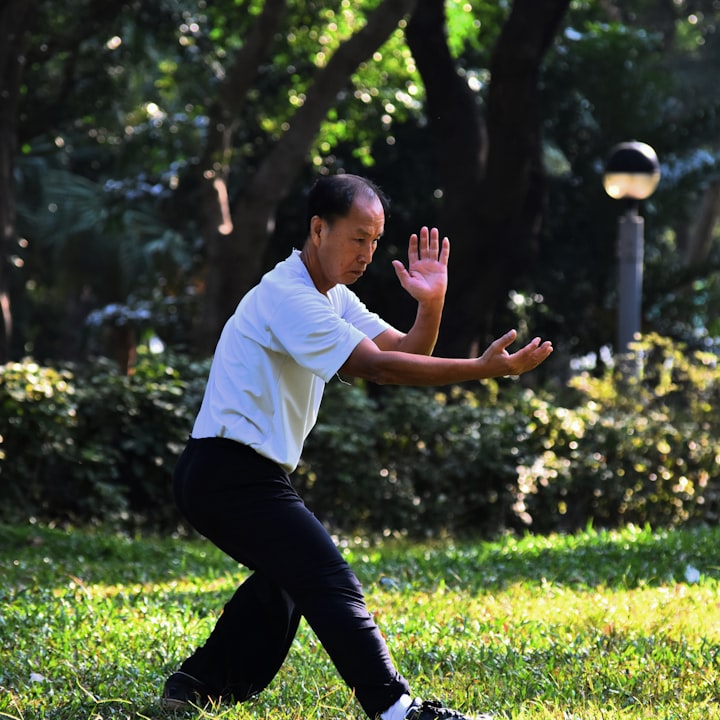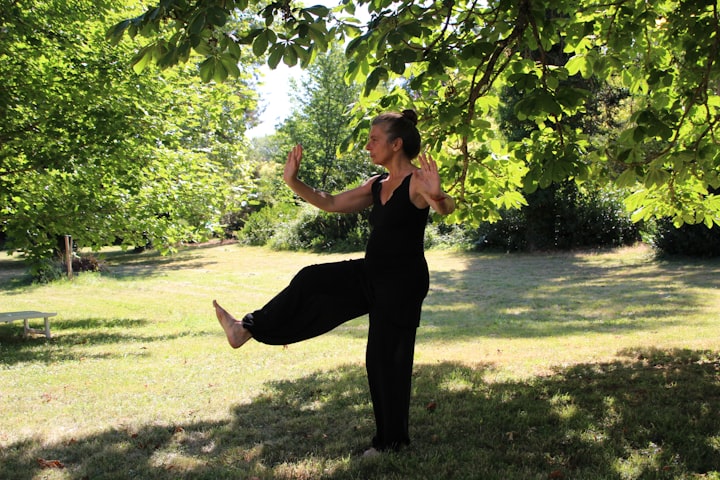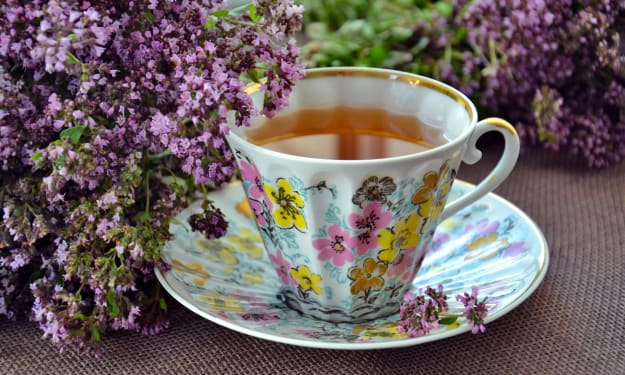4 Ways Qigong can help you heal your mind and body
Building strong Qigong all day long

One time while I was in California, I came across an interesting old man.
It was during my usual morning walk in Pasadena. Passing a nearby park, I noticed someone in the grass moving so slowly.
This man was in the midst of doing something that, from the outside, looked so strange and peculiar. Still, something compelled me to stay and take notice.
He was moving at a snails pace and shifted his body from place to place. I’d soon discover that he was in the middle of performing a powerful practice.
Minute and methodical movements that were like medicine for body and mind. And yet he also seemed to have a martial prowess.
Even though he looked to be in his later years, he did not project or give off any sense of fear.
Seeing this encouraged me to draw near and, when I waited him for him to finish, I gave him my listening ear.
He told me his practice was Tai Chi and Qigong, and that these two things were what kept him strong.
He said that he practiced daily and was not about to quit. His energy levels impressed me more than I’m inclined to admit.
Qigong

What is Qigong?
Qigong is an ancient Chinese tradition that has been practised for thousands of years as part of traditional Chinese medicine.
Qigong is a traditional Chinese practice that includes various exercises and meditative techniques. The word “qigong” is made up of two Chinese characters: “qi” (pronounced “chee”) meaning life energy, and “gong” meaning work or skill.
In other words, you could say it is the skill of cultivating life energy. Allowing you to work with the Qi that surrounds you and me. The Qi that makes up all life.
How does Qigong work?
Qigong is said to improve one’s health by promoting the flow of qi (life energy) in the body.
The practice is also said to have a positive effect on the mind and spirit.
There are many different qigong practices, each with its own specific exercises and techniques.
Some qigong practices are very active, while others are quite passive.
Qigong is often practised in groups, but it can also be done alone. The practice is very practical in that it can be done anywhere, at any time.
Qigong practitioners use a variety of techniques, including movement, meditation, and breathing exercises, to Balance the qi and improve health.
Benefits of Qigong

1. Qigong helps in reducing pain
A study published in 2019 followed 72 office workers who were suffering from low back pain.
Half of the subjects participated in a qigong class for six weeks, while the other half did not.
The qigong participants reported less low back pain than the control group.
Qigong is effective in reducing pain for a number of reasons.
First, it helps to improve circulation and increase blood flow to the areas of the body that are in pain.
This increased blood flow helps to reduce inflammation and swelling, which can lead to pain relief.
Additionally, qigong helps to release endorphins, which are the body's natural painkillers.
Finally, qigong helps to stretch and strengthen the muscles and tendons, which can help to prevent or reduce pain caused by tension or strain.
2. Qigong promotes fitness and flexibility
Qigong is a form of exercise that promotes fitness and flexibility.
It is a low-impact form of exercise that can be performed by people of all ages and fitness levels.
Qigong is a safe and effective way to improve your overall health and well-being.
Baduanjin qigong is a great way to get your body moving and improve your fitness.
In a 2016 review, researchers looked at previous studies to learn how this activity might help improve your overall fitness.
The evidence suggests that Baduanjin qigong can be helpful in improving balance, hand grip strength, torso flexibility, blood pressure, and resting heart rate.
3. Qigong promotes respiratory health
A recent paper argues that qigong could be a helpful complementary therapy for older adults who want to reduce their risk of developing viruses.
The researchers have found that several qigong breathing techniques can be beneficial for reducing stress, strengthening respiratory muscles, reducing inflammation, and supporting the immune system.
Qigong is a form of traditional Chinese medicine that involves the use of various breathing exercises to promote overall health.
While qigong can be used to treat a variety of health conditions, it is particularly effective in promoting respiratory health.
The breathing exercises involved in qigong help to improve lung function and increase the amount of oxygen that is circulated throughout the body.
Moreover, qigong helps to clear out mucus and other respiratory irritants, making it an effective treatment for conditions such as asthma and bronchitis.
4. Qigong improves mental health
A 2017 review on cancer survival found that qigong may help lessen depression.
A 2019 analysis of prior studies also found that the practice may have an antidepressant effect.
Qigong is a form of Chinese exercise that involves slow, controlled movements and deep breathing.
It has been shown to improve mental health by reducing stress and anxiety, improving mood, and increasing self-esteem.
Qigong has also been shown to improve cognitive function and reduce the risk of developing dementia.
Hence, the reason the man I met stayed sharp into his elder years!
Qigong for beginners

There are lots of ways to get started with qigong. It can be helpful to figure out what kind of qigong you want to learn, and what style of learning works best for you.
Doing this is beneficial before you start looking for classes or other resources.
Here are some things to be aware of for beginners:
1. What is the Goal
When choosing a type of qigong to practice, it can be helpful to have a primary goal in mind.
For example, you may be interested in managing a chronic condition, improving fitness, or boosting mental well-being.
You may also be drawn to it as a form of meditation. Allowing you to relax and de-stress.
Another method of this modality is the martial art application. As it can be dangerous in a form of self-defense.
2. Medium to learn
What are your qigong goals? After you identify your goals, you can think about the best way for you to learn qigong.
Do you prefer in-person classes, video tutorials, or books?
There are countless ways to work with this tool and, as you already know, anything works if you work it.
3. Finding Resources
Once you know what you want to focus on and how you want to learn, you can start looking for the information or class you need.
This step is essential for you to succeed, but try not to get bogged down in the feed.
4. Asking questions
Before you attend a class with a qigong teacher, it's always a good idea to ask about their style and approach.
For example, you could ask how physically demanding the sessions are, or whether the style is traditional or modern.
5. Trying Different styles
Qigong offers many benefits, and there are many different styles to choose from. People may wish to try out different styles before settling on one that they like best.
“To know the road ahead, ask those coming back.” ~Chinese Proverb
A couple of my Qigong instructors along the years have been Dan Bernardo and Elitom Elamin.
Dan Bernardo is an instructor at the WellWithin Martial Arts Dojo in Columbia, South Carolina.
When I trained there, he taught me a style of Qigong called “8 Brocades”. Also known as Baduanjin.
This style gave me the benefit of incorporating breath and movement. It expanded me in ways that supercharged my days the more I practiced.
Another teacher of mine has been my mentor, Elitom Elamin. A practitioner for over 20+ years and a pioneer of Pranic Living.
I learned from Elitom, a style of Qigong called Zhàn Zhuāng. Also known as “standing like a tree”.
This form of Qigong is also powerful because it allows you to cultivate energy by using positions that align your spine.
Just like a tree extends and gets nourishment from the sun, we too are able to gather energy from the Qi that surrounds us.
This method works directly with your central nervous system and, when practiced regularly, can greatly promote health and vitality.

Final words
Qigong is an ancient Chinese practice that traditionally focuses on the mind, body and spirit.
By ensuring that a person's life force, or qi, flows freely through the body, qigong aims to promote a healthy and balanced life.
Thanks for reading! Comment below and let me know if you have tried Qigong before. If you have, what did you enjoy about it?
As a bonus, here’s a follow-along example of the style I learned.
About the Creator
The Breatharian Blogger
Here to inspire you on your journey. ✊🏾
Connect with me on IG @jromeshaw






Comments
There are no comments for this story
Be the first to respond and start the conversation.